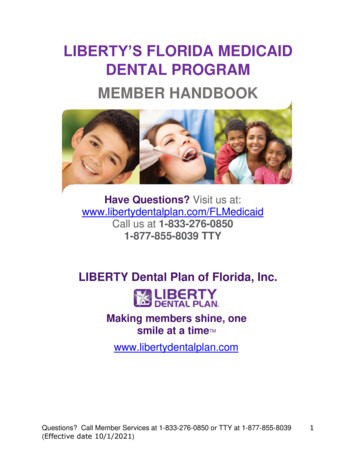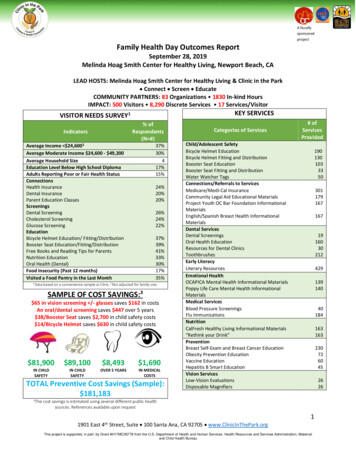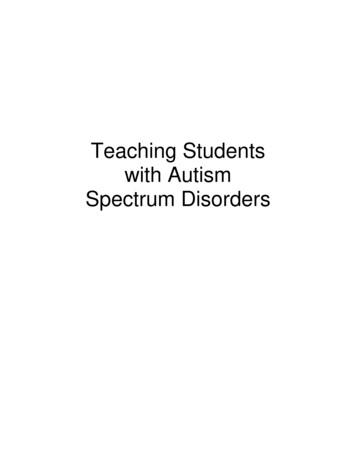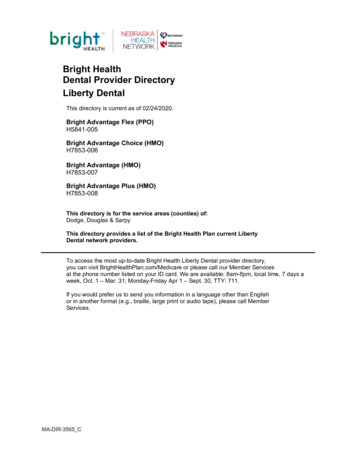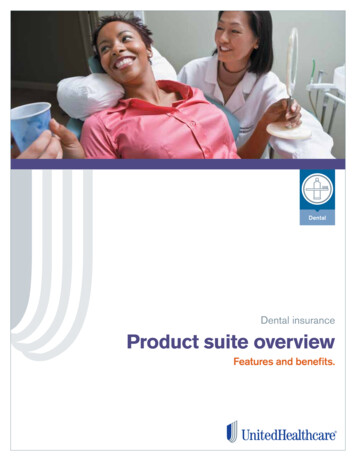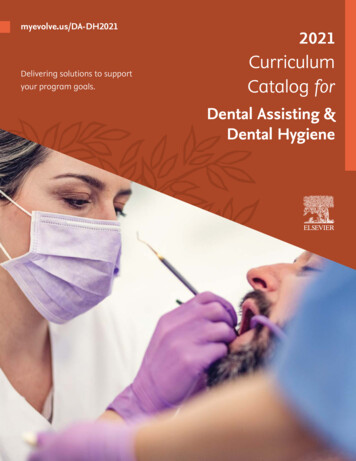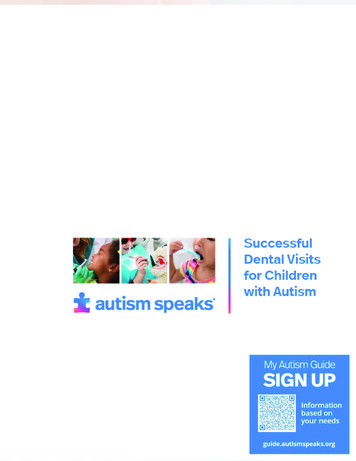
Transcription
Dental Guide
Getting Started at HomeFor FamiliesOral health is a very important component of healthy daily living. Butfor some children with autism, oral health habits can be challenging.Our hope is that this guide will provide information for families to helpbegin a lifetime of good oral care.To get started, you and your child should pick out the right toothbrush.There are many colors, styles, and types available. It is important that thebrush is the right size for your child’s mouth and that it has soft bristles.For some children with autism, brushing teeth can be difficult. Thesensation can be uncomfortable at first, and the child may need to bedesensitized. You may want to start by using the toothbrush to touchyour child’s lips or just inside the mouth. You may also want to teachyour child to “open wide,” so that this direction is understood. Showingyour child how you brush your own teeth may also be helpful.2
Brushing andFlossingBrushing Your Child’s Teeth Stand behind your child with their head on your chest. Put a pea size amount of toothpaste on the center of the brush. Guide the brush as if you were brushing your own teeth. There are six steps to brushing:1. Brush the outside, inside and tops of the bottom back teeth onone side of the mouth five times.2. Move up and brush the inside, outside and chewing surfacesof the top teeth five times.3. Brush the bottom front teeth outside and inside five times.4. Move to the opposite side and brush the bottom teeth outsideand inside five times.5. Brush the top front teeth inside, outside, and chewing surfacesfive times.6. Brush the opposite top back teeth inside, outside, and chewingsurfaces five times.Although most people brush their teeth in the bathroom, in order toaccommodate your child and get them accustomed to brushing theirteeth, you may want to do this on the couch or in another part of yourhome where they may feel more comfortable. The ultimate goal is foryour child to brush their teeth as independently as possible.FlossingAnother important oral health skill that should be mastered is flossing.Just like brushing, this should be introduced as soon as possible in smallsteps, while building upon each success. The same technique is used inputting your child’s head on yourchest and flossing as you wouldyour own teeth. Floss one tooth at a time.Again, the goal is always for your childto achieve independencein this task.3
Other TipsOther Tips That May Be Helpful Some families find it useful to use a timer so that the individualwith an autism spectrum disorder (ASD) can see when the taskwill be over. Some individuals with autism benefit from visual supports andschedules. A visual schedule can be created by taking photographsof the steps outlined on the previous page.- Families can then print the pictures and create visual schedulesfor their child. Some families may print the page and check offthe activities as they occur. The pages can be laminated and a dryerase marker can be used to check off each activity, this way thepage can be reused.- Others may cut out the photos and laminate them, and placeVelcro on the back of each photo. The photos are arranged inchronological order on a board, and as each step is completed,the corresponding picture is removed. Another option is to photograph each step of the teeth brushingprocess, load the pictures on to a digital picture frame and programit so that each photo is displayed for 10 second intervals. This can beused in the bathroom as they are brushing their teeth so that theyhave a visual prompt when it is time to move on to the next step.* Some individuals need to be reinforced with verbal praise or a rewardafter each step. Others may be able to complete some, many, or all of thesteps before verbal praise or a treat is needed. Each child will need to workat their own pace to achieve the skills necessary to brush their teeth.Once a manual toothbrush has been mastered, then a power brush canbe introduced. The power brush is slightly different in that the brushdoes the work, so the individual no longer needs to do the “brushing.”In all cases, the ultimate goal is for the individual with autismto brush their teeth as independently as possible.4*This type of visual support was developedby Gloria Satriale, Executive Director of PAAL(Preparing Adolescents for Adult Life).
Preparing for theDental VisitFinding the Right Dental OfficeIt is important to find a dentist that works successfully with individualswith autism. You may find a dentist in your local area in the AutismSpeaks Resource Guide. (www.AutismSpeaks.org/community/resources)You may want to find out if the dentist has a questionnaire that you canfill out before your appointment. If not, you can use the one provided inthis guide.Speak with the dentist before the appointment. Let the dentist know what time of day works best for your child. Describe any concerns or challenges that may present themselvesduring the visit. See if they have pictures of the office so you can review them withyour child before the appointment.Preparing for the Dental VisitYou may want to prepare your child before going to the dentist. Forsome children, a visual schedule can be helpful to let them know whatwill happen throughout the visit. You can find information about visualschedules on page 6, and you can find an actual visual schedule on page7 of this Guide. You can also practice having your child sit in a recliningchair. You may have to teach each of the following steps so that theyunderstand the directions from the dental professional. Putting their hands on their stomach Putting their feet out straight Opening wide Holding their mouth open Counting their teeth Cleaning with a power brush Taking X-Rays Spitting into the sinkEach step may need to be mastered individually. Many of the instrumentsused at a dental visit can be bought at a drugstore. These would include: Small flashlight Dental mirror Rubber-tipped gum massager5You may also be able to get some dental bite wings from their dentist inadvance of the visit, so that your child may practice biting down on thedental bite wings when they need to have X-Rays taken.
Visual ScheduleIndividuals with autism often benefit from visual supports andschedules. The following visual schedule outlines the steps necessaryfor a dental visit. Families are welcome to print the pictures and createa visual schedule for their child. Some families may print the page andcheck off the activities as they occur. The pages can be laminated anda dry erase marker can be used to check off each activity, this way thepage can be reused for each visit. Others may cut out the photos andlaminate them, and place Velcro on the back of each photo. The photosare arranged in chronological order on a board, as each step is completedthe picture is removed.Some children may need to be reinforced with verbal praise, a preferreditem, or a reward after each step. Others may be able to complete some,many or all of the steps before verbal praise or a reward is given. Eachchild will need to work at their own pace to achieve the skills necessaryfor a dental visit.6
Visual Schedule for a Dentist Visit1 Put hands on stomach 2 Feet out straight 3 Open mouth wide 4 Hold mouth open 5 Count teeth 6 Take X-Rays 7 Clean teeth 8 Spit into sink
Going to Dentist8Meeting the DentistYour child will most likely meet the dentist in the waiting area. Youmay want to call ahead to see if the dentist is running on time. If theyare delayed and you think that your child may be anxious in the waitingarea, you may want to ask the receptionist if you could wait in the car,and ask them to call you on your cell phone when the dentist is ready.Bring a favorite toy or reward for a job well done. You may also want tobring a family member, teacher, or autism expert to help make thevisit a success.
For the DentistWhat is Autism?Autism, or autism spectrum disorder (ASD), refers to a broad range ofconditions characterized by challenges with social skills, repetitivebehaviors, speech and nonverbal communication. We now know thatthere is not one autism but many subtypes, and each person with autismcan have unique strengths and challenges. A combination of genetic andenvironmental factors influence the development of autism, and autismoften is accompanied by medical issues such as GI disorders, seizures andsleep disturbances. Autism affects an estimated 1 in 59 children.Individuals with ASD have difficulties with: Social Interactions Communication Difficulty relating or participating in a back-and-forth conversationor interaction Repetitive or stereotypical behavior Individuals with ASD may also be hypersensitive or hyposensitiveto light, sound, touch, smell, or taste.Advice for Dental Experts Develop a relationship with your patient with autism. Speak in a calm and soothing voice. Get down to the child’s level and be confident and reassuring. Do not ask the child if they want to come with you, but rather gentlytell the child what you are doing next. Be consistent.9
For the DentistGetting Your Office ReadySince each child with autism is different, some suggestions may workfor one patient with autism, but not for another. Ask the parent first ifthere are often suggestions that may better meet the needs of yourpatient with an ASD. Dim the lights if necessary. Turn down loud noises. Turn on instruments so that the child can see them before theinstruments go in their mouths. Remove the clutter in your office that may distract the child or makethem anxious. Let the child know what you will be doing. You may want to show thechild on their hand how you will be counting their teeth so that theyknow what is going to happen. Make sure to provide clear and accurate information when speakingto the child. End each visit on a positive note, so that you and your patient canbuild upon your success.Sometimes it may take several visits in order to complete a dental exam.If you work with the family on this process, you will build a relationshiptogether that will result in a life time of good dental health for childrenwith autism.10
About UsAbout Autism SpeaksAutism Speaks is dedicated to promoting solutions, across the spectrumand throughout the life span, for the needs of individuals with autismand their families. We do this through advocacy and support; increasingunderstanding and acceptance of people with autism; and advancingresearch into causes and better interventions for autism spectrumdisorder and related conditions. Through partnerships and collaboration,we are committed to: Increasing global understanding andacceptance of people with autism Being a catalyst for research breakthroughs Increasing early childhood screening andtimely interventions Improving the transition to adulthood Ensuring access to reliable information andservices throughout the life spanTo find resources, join a fundraising walk or make a donation, go towww.AutismSpeaks.org.11
CreditsIllustrations by: Joe SheaSpecial Thanks to: Karen A. Raposa, RDH, MBA, Gail B. Stoops, RDH,BSDH, Nicole Weidenbaum, M.S. Ed., SAS, Executive Director NSSA,Kathy Mannion, Associate Director, NSSA, Students, clients andstaff at Nassau Suffolk Services for Autism (NSSA), Richard Holstein,D.M.D., Stanton E Young, D.M.D., Dr. Michele Savel, D.D.S., andKiddsmiles Pediatric Dentistry.www.nssa.net12www.kiddsmiles.com
Dental Form for Your Dentist VisitMEDICAL INFORMATIONPatient Name:Parent/Guardian:Phone Number:Parent/Guardian:Describe the nature of your child’s disability:Are they currently taking any medications? YES NOIf yes, what medications:Has your child ever had seizures? YES NOIf YES, date of last seizure:Describe the type of seizure:Do you have any allergies? YES NOIf yes, please list:Does your child wear a hearing aid? YES NOIf YES, please explain:Does your child have any other physical challenges that the dentalteam should be aware of?ORAL CAREHas your child visited the dentist before? YES NOIf yes, please describe:Please describe your child’s at-home dental care:1
Dental Form for Your Dentist VisitDoes your child use a powered toothbrush or a manual toothbrush? YES NODoes your child floss? YES NODoes your child brush independently or with parent/guardian’s assistance? YES NOWhat are your dental health goals?How often does your child snack during the day and on what types of foods?COMMUNICATION & BEHAVIORIs your child able to communicate verbally? YES NOAre there certain cues that might help the dental team?Are there any useful phrases or words that work best with your child?Does your child use non-verbal communication? YES NOPlease check any of the following that your child uses:O Mayer Johnson SymbolsO Sign LanguageO Picture Exchange Communication System (PECS)O Sentence Board or GesturesWill you be bringing a communication system with you? YES NOAre there any symbols/signs that we can have available to assist with communication?BEHAVIOR/EMOTIONSAre there any specific behavioral challenges that you would like the dental team to be aware of?2
Dental Form for Your Dentist VisitSENSORY ISSUESAre there any sounds that your child is very sensitive to?Does your child prefer the quiet? YES NOIs your child more comfortable in a dimly lit room? YES NOIs your child sensitive to motion and moving (i.e., the dental chair moving up anddown or to a reclining position)?Does your child have any specific oral sensitivities (gagging, gum sensitivities, etc.)?Do certain tastes bother your child?Is your child more comfortable in a clutter-free environment? YES NOPlease provide us with any additional information that may help us to prepare for asuccessful dental experience:3
Dental Guide. For Families 2 Getting Started at Home Oral health is a very important component of healthy daily living. But for some children with autism, oral health habits can be challenging. Our hope is that t
